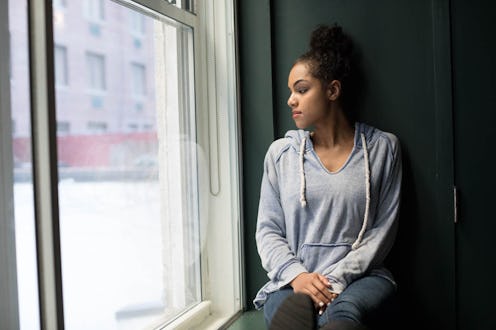Life
These Tweets Speak Volumes About Living With Anxiety

All too often, living with anxiety means fighting the perception that you're prone to exaggeration — that your worries are an indulgence or affectation rather than a source of distress. In February, mental health advocate Sarah Fader created the hashtag "This Is What Anxiety Feels Like" to give people a glimpse into the life of someone with an anxiety disorder. Although everyone experiences anxiety sometimes, Fader's experiences and those shared by other Twitter users demonstrate the world of difference between anxiety as an emotion and anxiety as a chronic illness.
"I wanted to destigmatize and normalize anxiety. People with anxiety are often depicted as dramatic exaggerators and I wanted to debunk that," Fader tells Bustle over email, adding that she also wanted "to not feel alone." In the Huffington Post, she wrote that the idea originated during a weekend when she was lonely and sick. When she texted someone and didn't hear back, Fader began to worry about having offended her friend, and she tweeted about her emotions, adding the hashtag #ThisIsWhatAnxietyFeelsLike. After receiving some supportive tweets, she decided to open up the floor and invited others to share their experiences with anxiety.
"The response to the hashtag has been incredible," Fader writes, which just about sums it up. Hundreds of tweets have been tagged with the hashtag, and weeks later, it's still being used. Some tweets are tinged with irony.
Others take a more serious approach.
No matter how they chose to discuss anxiety, it's clear that many users welcomed the opportunity to talk about their experiences. According to Fader, it's formed a sense of solidarity among people who are often made to feel isolated by their disorder, which was what she intended in the first place. "Anxiety is an isolating illness and I wanted to form a community of fellow anxious people," she writes.
However, that wasn't her only aim. "I also wanted to educate loved ones who are with anxious partners," Fader tells Bustle. Sure enough, the tweets serve as a window into a disorder that is still stigmatized today — the obsessive thoughts, paralyzing fears, and other experiences that turn anxiety into an illness.
According to the National Institutes of Mental Health (NIMH), anxiety disorders are the most common type of mental illness among Americans, affecting 18 percent of the population. The prevalence of specific disorders varies. Generalized anxiety disorder, characterized by excessive worry about everyday problems, affects about three percent of American adults, while social phobia, or the fear of being watched or judged by others, is present in nearly seven percent.
Although anxiety affects millions of people, it's still stigmatized in many ways. Fader points out to Bustle that people with anxiety are often viewed as dramatic, blowing things out of proportion for no reason. However, people with anxiety are unable to control their worries — that's what makes it a disorder.
Unfortunately, this stigma has consequences on both a personal and societal level. The Centers for Disease Control has reported that downplaying mental illness can deter people from seeking treatment, and it can result in lower prioritization of public resources for mental health services.
The good news is that stigma can be fought by simply talking about mental illness, which is partly what makes "This Is What Anxiety Feels Like" significant. It might seem daunting to put such personal experiences online for the world to see, but Fader says it's worth it. "It is not difficult to share my story because I am doing it for the right reasons," she writes. "I want to show people that they can be brave and that they can speak about anxiety in a candid way."
All tweets have been used with permission from their users.